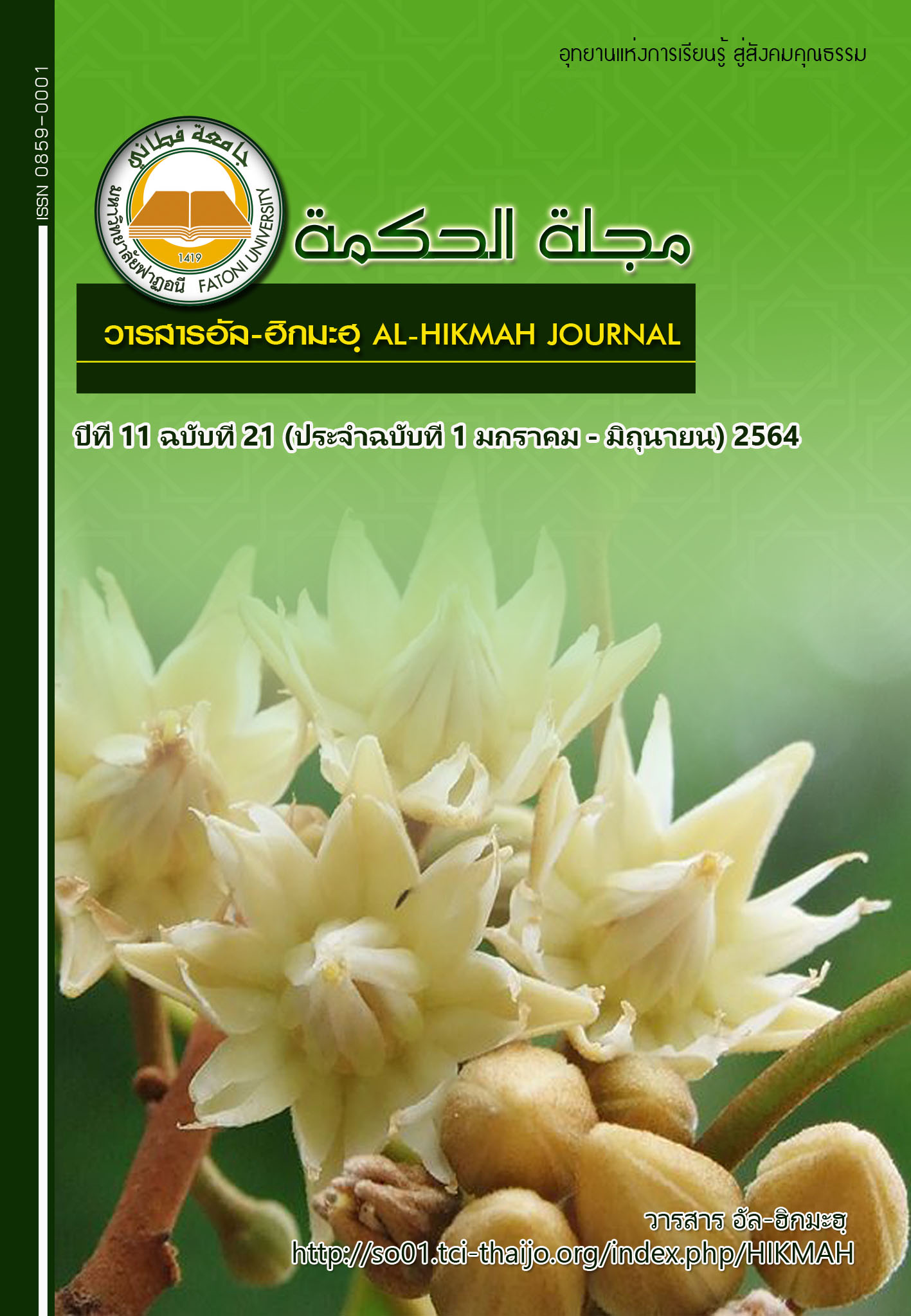The Risk Factors Affecting Online Shopping Addiction of Muslim Youth in Southernmost
Keywords:
Online Shopping Addiction, Muslim Youth in SouthernmostAbstract
This research aimed to analyze the risk factors affecting online shopping addiction and present addiction prevention strategies of Muslim youth in southernmost. The study was based on personal risk factors, behavioral factors, online shopping, a total of 20 independents. The sample was a youth in the southernmost aged between 15-18 years and is currently enrolled in the secondary schools 4-6 level. In this study, G*Power 3.1.9.2 was used to determine the sample size included 988 students. The tools used were questionnaires consisting of four parts: part one, general information of the sample, part two, risk factors influencing the addictive behavior of online shopping among Muslim youth in the southernmost using a Likert rating scale Scale, three: Online shopping addiction divided into five levels that adapted form from Canada. Frequency and percentage analysis were used for data analysis. Statistical mean and standard deviation were used to analyze the influencing factors of shopping behavior and multiple logistic regression analysis. The results found that risk factors influencing online shopping addiction among Muslim youth in southernmost there were trust, perceived risk, brand image, marketing promotion, the income of parents and Internet used. Moreover, there are four strategies for preventing the online shopping of Muslim youth in southernmost: proactive strategy, corrective strategy, preventive strategy, and defensive strategy.
References
ณรงค์พจน์ งามวงศ์วิเชียร. (2018). ปัจจัยส่วนประสมทางการตลาดและปัจจัยคุณภาพการให้บริการที่ส่งผลต่อความต้องการซื้อซ้ำกระเป๋าแบรนด์เนมมือสองของร้านวันใหม่ช้อปผ่านระบบออนไลน์ของผู้บริโภคในเขตกรุงเทพมหานครและปริมณฑล. Journal of Rangsit Graduate Studies in Business and Social Sciences, 4(2), 242-257.
ทวีรัชต์ คงรชต. (2018). ปัจจัยส่วนประสมทางการตลาดที่ส่งผลต่อพฤติกรรมการซื้อสินค้าผ่านระบบออนไลน์ของคนวัยทำงานในจังหวัดนนทบุรี. Kasetsart Applied Business Journal, 12(16), 40-60.
ทิวาพร สำเนียงดี, & ภักดีมานะ หิรัญเวท. (2015). ปัจจัยที่มีผลต่อพฤติกรรมการสั่งซื้อพิซซ่าของ“เดอะพิซซ่าคอมปะนี ”ทางอินเทอร์เน็ตในเขตกรุงเทพมหานคร. Journal of Rangsit Graduate Studies in Business and Social Sciences, 1(1), 32-42.
บูรณ์คณัส จันทรศิริพุทธ, พิชญ์ชญานิษฐ์ รองสวัสดิ์, บูรณ์คณัส จันทรศิริพุทธ, & พวงผกา ดำรงเสรี. (2014). สุขภาพจิต และพฤติกรรมการดูแลตนเองด้านสุขภาพจิตของวัยรุ่นในโรงเรียนมัธยมศึกษา จังหวัดยะลา. Journal of Nursing and Education, 7(1), 68-82.
ปรัชญา นวนแก้ว, วงษ์ปัญญา นวนแก้ว, นวพงษ์ ขันคำ, สุทธิษา กันจู & รัตนศักดิ์ เพ็งชะตา. (2019). การศึกษาความพึงพอใจในการตัดสินใจเลือกซื้อเครื่องสำอางผ่านสื่อออนไลน์. โครงงานวิทยาการคอมพิวเตอร์และเทคโนโลยี สารสนเทศ, 5(1), 104-112.
มณีรัตน์ รัตนพันธ์. (2015). ปัจจัยทางการตลาดที่มีผลต่อการตัดสินใจซื้อสินค้าและบริการผ่านช่องทางออนไลน์ของผู้บริโภคในจังหวัดภาคใต้ตอนล่างประเทศไทย. Hatyai Academic Journal, 13(2), 145-153.
มนลภัส รัตนพันธ์. (2016). การตลาดออนไลน์การรับรู้ต่อเว็บเครือข่ายสังคม Facebook ที่มีผลต่อพฤติกรรมการซื้อสินค้านำเข้าจากเกาหลีโดยวิธีการสั่งซื้อล่วงหน้าผ่านเครือข่ายอินเทอร์เน็ต . วารสารบัณฑิตศึกษามหาวิทยาลัยราชภัฏสวนสุนันทา, 2(2), 88-104.
มัสลิน ใจคุณ, & รุจิภาส โพธิ์ทองแสงอรุณ. (2019). การยอมรับเทคโนโลยีความไว้วางใจและการตลาดผ่านสังคมออนไลน์ที่มีผลต่อความตั้งใจซื้อสินค้าผ่านช่องทางเฟซบุ๊กไลฟ์ (Facebook LIVE) ของกลุ่มผู้บริโภคGenerations X, Y, Z. Journal of Suvarnabhumi Institute of Technology (Humanities and Social Sciences), 5(1), 260-275.
วารุณี ศรีสรรณ์. (2017). การตัดสินใจซื้อสินค้าออนไลน์ของผู้บริโภควัยทำงานในเขตกรุงเทพมหานคร ปริมณฑลและต่างจังหวัด. Sakon Nakhon Graduate Studies Journal, 14(67), 41-46.
ศิริวรรณ พันธุ & ชาคริต ศรีทอง. (2019). ปัจจัยที่ส่งผลต่อการตั้งใจซื้อซ้ำผลิตภัณฑ์สมุนไพรเสริมอาหารผ่านออนไลน์ วารสาร วิทยาการจัดการปริทัศน์, 21(1), 63-72.
สุภาภรณ์ วิบุลศิลป์, กิตติพันธ์ คงสวัสดิ์เกียรติ, & วรรณรพี บานชื่นวิจิตร. (2017). ความพึงพอใจในการซื้อสินค้าและบริการผ่านช่องทางออนไลน์ของลูกค้าในเขต กรุงเทพมหานคร. Rajapark Journal, 11(23), 165-172.
อภิชยาภรณ์ ชุณหเวชสกุล, ปริญ ลักษิตามาศ, พิษณุ สันทรานันท์, & ชัยพล หอรุ่งเรือง. (2017). กลยุทธ์การตลาดเชิงสร้างสรรค์และการโฆษณาเนื้อหาการท่องเที่ยวไทยที่ส่งผลต่อพฤติกรรมการใช้จ่ายของนักท่องเที่ยวชาวจีนรุ่นเจเนอเรชั่นวาย. Modern Management Journal, 15(2), 117-130.
Ajzen, I. (1991). The theory of planned behavior. Organizational Behavior and Human Decision Processes, 50(2), 179-211.
Azlina, A.B., Fahmi, Z., Abdul, R., Wan, S., & Wong, A. (2016). Economic and utilitarian benefits of monetary versus non-monetary in-store sales promotions. Journal of Promotion Management, 10(4), 76-78.
Edwards, E.A. (1993). Development of a new scale for measuring compulsive buying behavior. Financ. Couns. Plann., 4(1), 67-84.
Davis, F.D. (1989). Perceived Usefulness, Perceived Ease of Use, and User Acceptance of Information Technology. MIS Quarterly, 13(3), 319-340.
Elsantiel, Y., & Harness, D. (2011). FACTORS AFFECTING EGYPTIAN ONLINE USERS'PERCEPTIONS OF AIRLINES'WEBSITE CREDIBILITY: A QUALITATIVE STUDY. International Journal of Arts & Sciences, 4(22), 355.
Fishbein, M. (1971). The relationships between attitudes and behaviors. New York: Harper and Row.
Hidayanto, A. N., Ovirza, M., Anggia, P., Budi, N. F. A., & Phusavat, K. (2017). The roles of electronic word of mouth and information searching in the promotion of a new e-commerce strategy: a case of online group buying in Indonesia. Journal of theoretical and applied electronic commerce research, 12(3), 69-85.
Hidayanto, A. N., Saifulhaq, H., & Handayani, P. W. (2012). Do consumers really care on risks in online shopping? An analysis from Indonesian online consumers. In 2012 IEEE International Conference on Management of Innovation & Technology (ICMIT) (pp. 331-336). IEEE.
Ijaz,M., & Rhee, J. (2018). Constituents and consequences of Online-shopping in Sustainable E-Business: An experimental study of Online-Shopping Malls. Sustainability, 10(10), 3756.
Kim, M.S. (2016). The Sources of Utilitarian Benefits and Hedonic Shopping Enjoyment, and Purchasing Intention in an Online Shopping Mall. International Journal of u- and e- Service, Science and Technology, 9(10), 375-386.
Mahadin, B. K., & Akroush, M. N. (2019). A study of factors affecting word of mouth (WOM) towards Islamic banking (IB) in Jordan. International Journal of Emerging Markets.
Manan,H.A.,Ariffin,S.,Maknu,T.S.R., Ibrahim,I.,& Jaafar, H. S. (2019). Factors Affecting Willingness To Accept Foreign Halal Foods By Urban Malaysian Malays. Journal of Emerging Economies & Islamic Research, 7(1).
Mariani, M., & Lamarauna, A. M. I. (2017). The Impact of Social Influence and Trust on Customer-to-Customer Online Shoppers' Purchase Intention: An Empirical Study in Indonesia. GSTF Journal on Computing, 5(3).
Mattos, C.N.D., Kim, H.S., Requião, M.G., Marasaldi, R.F., Filomensky, T.Z., Hodgins, D.C., & Tavares, H. (2016). Gender Differences in Compulsive Buying Disorder: Assessment of Demographic and Psychiatric Co-Morbidities. PLOS ONE, 11(12), 44-45.
Putri, J. W. (2015). Factors Affecting Customers Online Search Intention and Online Purchase Intention using Social Networks: Case Study of Online Shop on Instagram. iBuss Management, 3(2).
Rahmaningtyas, A., Hartono, S., & Suryantini, A. (2017). Factors Affecting Online Purchasing of Local Food. Agro Ekonomi, 28(2), 189-204.
Rogers, E.M. (1976). Communication and development the passing of the dominant
paradigm. Communication research, 3(2), 213-240.
Suki, N. M. (2013). Consumer shopping behaviour on the Internet: Insights from Malaysia. Electronic Commerce Research, 13(4), 477-491.
Saba, A., & Messina, F. (2003). Attitudes towards organic foods and risk/benefit perception associated with pesticides. Food Quality and Preference, 14(8), 637-645. doi: https://doi.org/10.1016/S0950-3293(02)00188-X
Soderstrom, S., Uzzi, B., Rucker, D., Fowler, J., & Diermeier, D. (2016). Timing Matters: How Social Influence Affects Adoption Pre- and Post-Product Release. Sociological Science, 3, 915-939.



